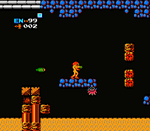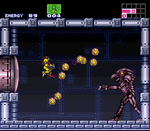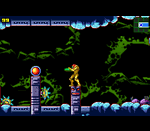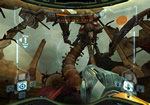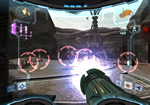About the series
Interested in learning more about Metroid? The very first title of the series arrived in Japan over twenty years ago in 1986 for the fledgling Nintendo Entertainment System (NES). Developed by Nintendo's R&D1 division, produced by Gunpei Yokoi and directed by Yoshio Sakamoto, Metroid introduced gamers to Samus Aran - a futuristic bounty hunter equipped with a powerful battle suit.
 The story begins as Samus is recruited by the Galactic Federation - the ruling government of the cosmos - to infiltrate and eliminate the Space Pirates - sworn enemies of galactic civilization, hidden within their fortified world of Zebes.
The story begins as Samus is recruited by the Galactic Federation - the ruling government of the cosmos - to infiltrate and eliminate the Space Pirates - sworn enemies of galactic civilization, hidden within their fortified world of Zebes.
 Previously, the Space Pirates had stolen several specimens of a recently discovered lifeform known only as Metroids. These parasitical beings - central to the entire series - possessed the uncanny ability to drain the very life essence from any biological creature, rendering these parasites deadly in the wrong hands.
Previously, the Space Pirates had stolen several specimens of a recently discovered lifeform known only as Metroids. These parasitical beings - central to the entire series - possessed the uncanny ability to drain the very life essence from any biological creature, rendering these parasites deadly in the wrong hands.
Themes introduced in Metroid paved the way for future titles, introducing us to the atmosphere and isolation of Samus' missions across alien worlds.
Samus' crucial Power Suit allowed for a multitude of upgrades, either providing the right offensive weaponry for the job or the ability to clear obstacles barring the path forward. Non-linear worlds granted players complete freedom to explore and chart out the game world, often requiring backtracking to access previously inaccessible regions.
Metroid II - Return of Samus arrived soon after for the original Game Boy, taking Samus to the Metroid's homeworld and introducing further upgrades and encounters against hordes of the parasites. Super Metroid for the Super NES raised the bar higher, and is often considered the best the series has to offer.
Metroid Prime arrived in 2002, taking players inside Samus' helmet with the jump to an ambitious 3D first-person perspective. The rest is history...
Samus Aran
 As with any highly-respected bounty hunter, Samus' history is often shrouded in secrecy. Even the original Metroid kept its biggest secret to the very end - upon completing the game within a specific time limit, players would discover the true identity of the hunter.
As with any highly-respected bounty hunter, Samus' history is often shrouded in secrecy. Even the original Metroid kept its biggest secret to the very end - upon completing the game within a specific time limit, players would discover the true identity of the hunter.
Future Metroid titles continued the tradition of rewarding players with fast completion times by revealing Samus under her armour, giving us a glimpse of the human within the mechanised suit.
Revealed in Metroid: Zero Mission and via a series of Manga, we learn that Samus was once part of the human colony K-2L at a very young age.
The only survivor of a lethal Space Pirate attack leaving her orphaned and alone, Samus was rescued and subsequently raised by members of the Chozo race. Ancient bird-like beings, masters of technology and bearers of much wisdom, the Chozo saw potential in Samus and gave her a new purpose in life.
Infusing her blood with the strength of their own and building her custom Power Suit with all the gear she'll ever need out in the field, the Chozo trained Samus in their ancient art of combat to one day help undo all the terror and destruction the Space Pirates so callously inflicted upon the galaxy.
The Metroid games
Both 2D and 3D Metroid games feature huge worlds offering free exploration for Samus as she locates hidden power-ups and battles the Space Pirate's minions.
Using classic platforming action, Samus can jump, shoot and climb her way through the environments riddled with secrets to uncover, while utilising a wide array of abilities. Normally the games required players to search for items in a specific order, but the non-linear open nature of the game worlds allowed for much sequence breaking.
The series jumped to full 3D in Retro Studios' first Metroid Prime for Nintendo's GameCube. Switching to a first-person view for a complete experience from the eyes of Samus, Metroid Prime is far from your regular first-person shooter.
The viewpoint is about as much it has in common with other shooters - this was purely an adventure title in the Metroid universe. Since then, the Prime series expanded with a solid sequel and a conclusion to the trilogy on the Nintendo Wii, along with a pair of spin-off games for the portable Nintendo DS system - proving that the often dangerous jump to 3D was worth the gamble.
The Metroid timeline
Although Samus most often works alone for the best portrayal of isolation and exploration, the story element certainly doesn't suffer. The games do follow a specific timeline, although it doesn't follow the chronology of each game's release over the last 20 years. The official timeline is as follows:
- Metroid (NES) / Metroid: Zero Mission (Game Boy Advance)
- Metroid Prime (GameCube) / Metroid Prime Pinball (Nintendo DS)
- Metroid Prime Hunters (Nintendo DS)
- Metroid Prime 2: Echoes (GameCube)
- Metroid Prime 3: Corruption (Nintendo Wii)
- Metroid II: Return of Samus (Game Boy) / Metroid: Samus Returns (Nintendo 3DS)
- Super Metroid (Super Nintendo)
- Metroid: Other M (Nintendo Wii)
- Metroid Fusion (Game Boy Advance)
Check out each specific game's section for more information on each title for release dates, story details and complete walkthroughs. Enjoy the ride!












